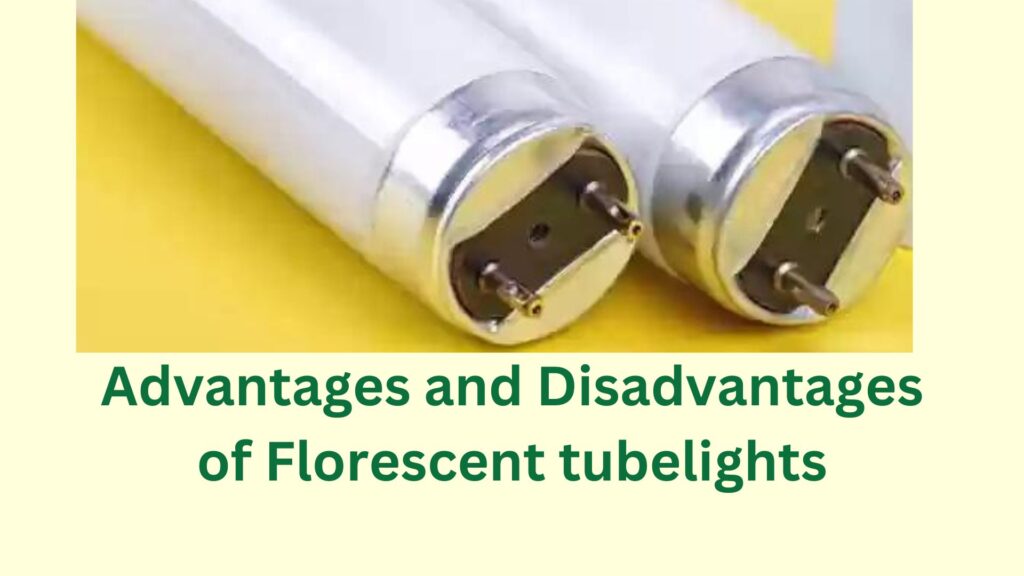Shortly after the invention of fluorescent tube lights, they quickly established themselves as a viable alternative to incandescent lighting. This transition was driven by several compelling factors. In this post, we aim to comprehensively examine both the advantages and disadvantages associated with fluorescent tube lights. By exploring these aspects in detail, we can gain a thorough understanding of their impact and suitability across various applications. So Lets discuss Advantages and disadvantages of using Florescent tubelights over other light sources.

Advantages of Florescent tube lights
- Energy Efficiency: Fluorescent tubelights works by using less energy compared to incandescent bulbs, providing significant energy savings.
- Longer Lifespan: They typically last longer than traditional incandescent bulbs, reducing the frequency of replacements.
- Cost-Effective: Lower energy consumption and longer lifespan result in reduced overall costs over time.
- Bright Light Output: Fluorescent tube provide a bright, even light, which is ideal for illuminating large spaces like offices, schools, and retail areas.
- Low Heat Emission: They emit less heat compared to incandescent bulbs, making them safer and more comfortable in confined spaces.
- Variety of Color Temperatures: Available in different color temperatures, from warm to cool, to suit various lighting needs and preferences.
- Environmentally Friendly: They consume less electricity, leading to reduced greenhouse gas emissions from power plants.
- Good Color Rendering: Fluorescent lights have a decent color rendering index (CRI), which means they can accurately reflect colors in a space.
- Low Operating Costs: Due to their energy efficiency and longevity, operating costs are lower compared to other types of lighting.
- Versatile Applications: Suitable for a wide range of applications including residential, commercial, and industrial settings.
Disadvantages of Fluorescent Tube Lights
Apart from their advantages, fluorescent tube lights also have some serious disadvantages, which are discussed below:
- Contains Mercury: Fluorescent tubes contain mercury, which is a hazardous substance. Proper disposal and recycling are necessary to prevent environmental contamination.
- Initial Cost: Although they save money in the long run, the initial cost of fluorescent tube lights and fixtures can be higher than incandescent bulbs.
- Flickering: Some fluorescent lights can flicker, which can cause discomfort or eye strain for some people. This is especially noticeable as the tubes age or if the ballast is faulty.
- Color Rendering: The color rendering index (CRI) of fluorescent lights is generally lower than that of incandescent bulbs, which can make colors appear less vibrant and accurate.
- Temperature Sensitivity: Fluorescent lights can be less effective in very cold temperatures, affecting their performance and light output.
- Noise: Some fluorescent lights can produce a humming or buzzing sound, which can be distracting or annoying in quiet environments.
- Warm-Up Time: Fluorescent tubes often require a brief warm-up period before reaching full brightness, which can be inconvenient.
- Lifespan Affected by Switching: Frequent switching on and off can reduce the lifespan of fluorescent tubes, making them less suitable for areas where lights are turned on and off frequently.
- Dimming Capabilities: Standard fluorescent lights are not easily dimmable and require special dimming ballasts and controls, adding to the cost and complexity.
- Health Concerns: Some people are sensitive to the UV radiation emitted by fluorescent lights, which can cause headaches or other health issues.
Despite the disadvantages of fluorescent tube lights, they were widely used for many years before being gradually replaced by LED tube lights. Currently, companies are producing fewer components for fluorescent tube lights due to declining demand and the shift towards more energy-efficient and environmentally friendly lighting solutions such as LEDs. This transition marks a significant evolution in lighting technology, reflecting advancements in efficiency and sustainability in the industry.